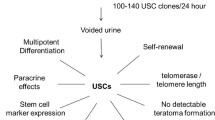Abstract
To determine the ability of cultured bone marrow-derived mesenchymal stem cells (BMSCs) to differentiate into functional urothelium. BMSCs were isolated from the long bones of aborted fetal limbs by Percoll density gradient centrifugation and characterized by flow cytometry. Human fetal urinary bladders were cut into small pieces and cultured for 3–5 days until the growth of urothelial cells was established. BMSCs were then cocultured with neonatal urothelial cells and subsequently evaluated for antigen expression and ultramicrostructure, by immunocytochemistry and electron microscopy, respectively. A subset of BMSCs expressed the differentiation marker CD71. The BMSC markers CD34, CD45, and HLA-DR were barely detectable, confirming that these cells were not derived from hematopoietic stem cells or differentiated cells. In contrast, the stem cell markers CD29, CD44, CD105, and CD90 were highly expressed. BMSCs possessed the ability to differentiate into a variety of cellular subtypes, including osteocytes, adipocytes, and chondrocytes. The shapes of BMSCs changed, and the size of the cells increased, following in vitro coculture with urothelial cells. After 2 weeks of coculture, immunostaining of the newly differentiated BMSCs positively displayed the urothelial-specific keratin marker. Electron microscopy revealed that the cocultured BMSCs had microstructural features characteristic of epithelial cells. Pluripotent BMSCs can transdifferentiate into urothelial cells in response to an environment conditioned by neonatal urothelial cells, providing a means for the time-, labor- and cost-effective reconstruction of urinary bladder mucosa.




Similar content being viewed by others
References
Altschuler RA, O’Shea KS, Miller JM (2008) Stem cell transplantation for auditory nerve replacement. Hear Res 242:110–116
Anumanthan G, Makari JH, Honea L, Thomas JC, Wills ML, Bhowmick NA, Adams MC, Hayward SW, Matusik RJ, Brock JW 3rd, Pope JC 4th (2008) Directed differentiation of bone marrow derived mesenchymal stem cells into bladder urothelium. J Urol 108:1778–1783
Bianco P, Riminucci M, Gronthos S, Robey PG (2001) Bone marrow stromal stem cells: nature, biology, and potential applications. Stem Cells 19:180–192
Blazejewska EA, Schlötzer-Schrehardt U, Zenkel M, Bachmann B, Chankiewitz E, Jacobi C, Kruse FE (2009) Corneal limbal microenvironment can induce transdifferentiation of hair follicle stem cells into corneal epithelial-like cells. Stem Cells 27:642–652
Bruce SJ, Gardiner BB, Burke LJ, Gongora MM, Grimmond SM, Perkins AC (2007) Dynamic transcription programs during ES cell differentiation towards mesoderm in serum versus serum-freeBMP4 culture. BMC Genomic 8:365
Chinen J, Buckley R (2010) Transplantation immunology: solid organ and bone marrow. J Allergy Clin Immunol 125(2 Suppl 2):S324–S335
Coleman B, Fallon JB, Pettingill LN, de Silva MG, Shepherd RK (2007) Auditory hair cell explant cocultures promote the differentiation of stem cells into bipolar neurons. Exp Cell Res 313:232–243
Fröhlich M, Grayson WL, Wan LQ, Marolt D, Drobnic M, Vunjak-Novakovic G (2008) Tissue engineered bone grafts: biological requirements, tissue culture and clinical relevance. Curr Stem Cell Res Ther 3:254–264
Grossman HB (1996) Superficial bladder cancer: decreasing the risk of recurrence. Oncology (Williston Park) 10:1617–1624 discussion 1624, 1627–1628
Hoffmann M, Chang HH, Huang S, Ingber DE, Loeffler M, Galle J (2008) Noise-driven stem cell and progenitor population dynamics. PLoS One 3:e2922
Ianus A, Holz GG, Theise ND, Hussain MA (2003) In vivo derivation of glucose-competent pancreatic endocrine cells from bone marrow without evidence of cell fusion. J Clin Invest 111:843–850
Kim WJ, Kim EJ, Kim SK, Kim YJ, Ha YS, Jeong P, Kim MJ, Yun SJ, Lee KM, Moon SK, Lee SC, Cha EJ, Bae SC (2010) Predictive value of progression-related gene classifier in primary non-muscle invasive bladder cancer. Mol Cancer 9:3
Li X, Yu X, Lin Q, Deng C, Shan Z, Yang M, Lin S (2007) Bone marrow mesenchymal stem cells differentiate into functional cardiac phenotypes by cardiac microenvironment. J Mol Cell Cardiol 42:295–303
Morganstein DL, Wu P, Mane MR, Fisk NM, White R, Parker MG (2010) Human fetal mesenchymal stem cells differentiate into brown and white adipocytes, and reveal a role for ERRα in human UCP1 expression. Cell Res 20:434–444
Patel P (2006) A natural stem cell therapy? How novel findings and biotechnology clarify the ethics of stem cell research. J Med Ethics 32:235–239
Pepper J, Sprouffske K, Maley C (2007) Animal cell differentiation patterns suppress somatic evolution. PLoS Comput Biol 3:e250
Qian L, Zhang ZG, Wen F, Fang Y (2006) Treatment of multiple superficial bladder tumors with bladder mucosal stripping in aged patients. J Med Theor Pract 19:1262–1263
Roeder I, Braesel K, Lorenz R, Loeffler M (2007) Stem cell fate analysis revisited: interpretation of individual clone dynamics in the light of a new paradigm of stem cell organization. J Biomed Biotechnol 2007:84656
Snykers S, Vanhaecke T, De Becker A, Papeleu P, Vinken M, Van Riet I, Rogiers V (2007) Chromatin remodeling agent trichostatin A: a key-factor in the hepatic differentiation of human mesenchymal stem cells derived of adult bone marrow. BMC Dev Biol 7:24
Tian H, Bharadwaj S, Liu Y, Ma PX, Atala A, Zhang Y (2009) Differentiation of human bone marrow mesenchymal stem cells into bladder cells: potential for urologic tissue engineering. Tissue Eng Part A16:1769–1779
Tondreau T, Dejeneffe M, Meuleman N, Stamatopoulos B, Delforge A, Martiat P, Bron D, Lagneaux L (2008) Gene expression pattern of functional neuronal cells derived from human bone marrow mesenchymal stromal cells. BMC Genomic 9:166
Wolff EM, Liang G, Jones PA (2005) Mechanisms of disease: genetic and epigenetic alterations that drive bladder cancer. Nat Clin Pract Urol 2:502–510
Yamada S, Nelson TJ, Crespo-Diaz RJ, Perez-Terzic C, Liu XK, Miki T, Seino S, Behfar A, Terzic A (2008) Embryonic stem cell therapy of heart failure in genetic cardiomyopathy. Stem Cells 26:2644–2653
Author information
Authors and Affiliations
Corresponding author
Rights and permissions
About this article
Cite this article
Ning, J., Li, C., Li, H. et al. Bone marrow mesenchymal stem cells differentiate into urothelial cells and the implications for reconstructing urinary bladder mucosa. Cytotechnology 63, 531–539 (2011). https://doi.org/10.1007/s10616-011-9376-3
Received:
Accepted:
Published:
Issue Date:
DOI: https://doi.org/10.1007/s10616-011-9376-3




